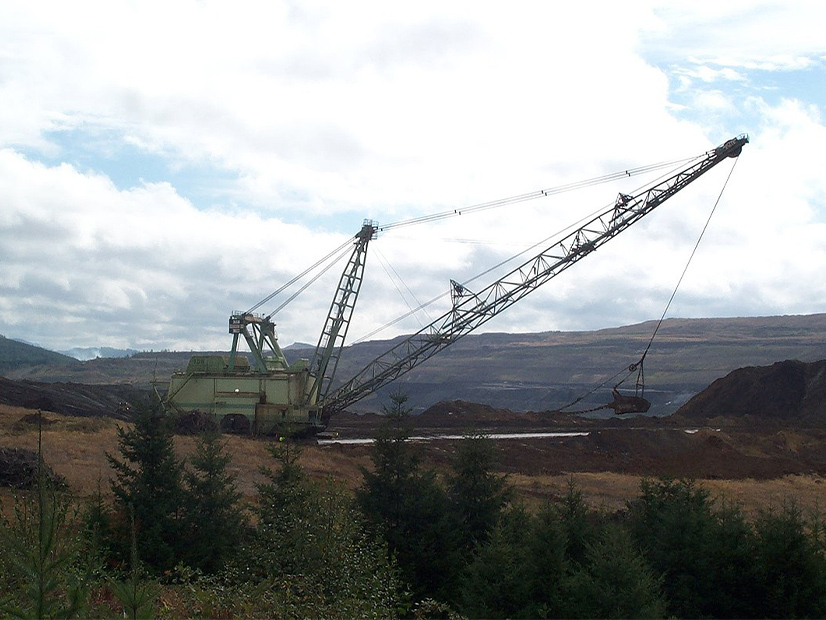
An Australian “global green energy company” is exploring the potential of converting a disused coal mine in Washington state into a facility for producing green hydrogen.
Fortescue Future Industries (FFI), a company with a mission to produce zero-carbon hydrogen on a large scale, said Friday that it would study the feasibility of using the mine for its green hydrogen project after entering into a binding exclusivity agreement with the community-owned Industrial Park at TransAlta (IPAT), located in Centralia, Wash.
The project site is adjacent to TransAlta’s coal-fired Centralia plant, which is scheduled to fully close in 2025. The first of two units at the plant was retired in 2020. Previously fueled by coal from the local mine, the plant now relies on Powder River Basin coal delivered by train.
In a statement posted on its website, FFI said the green hydrogen production facility “would enable the decarbonization of hard-to-abate sectors of the North American economy and support the development of a Pacific Northwest green hydrogen hub, potentially creating hundreds of new local jobs.”
The company said it intends for the proposed facility to employ the existing workforce from the coal plant, “facilitating a transition into the emerging green energy economy.”
“FFI’s goal is to turn North America into a leading global green energy heartland and create thousands of green jobs now and more in the future,” FFI founder and Chairman Andrew Forrest said in the statement. “Repurposing existing fossil fuel infrastructure to create green hydrogen to power the world is part of the solution to saving the planet.”
Forrest was formerly CEO of Fortescue Metals, a mining subsidiary of FFI.
FFI said it has been working with the Lewis County Energy Innovation Coalition and Lewis Economic Alliance to perform due diligence related to the project.
Under the 2011 agreement between TransAlta and the state of Washington to close the Centralia plant, TransAlta agreed to invest $55 million in the state, including $20 million for economic and community development and $5 million to support the training of workers displaced by the closure.
“With the closing of the coal mine and the scheduled retirement of the Centralia coal-fired power plant, IPAT was formed to redevelop the site and attract investment that will support well paid, long-term employment opportunities in the region. FFI’s potential project represents the opportunity to do just that,” said Richard DeBolt, executive director of the Lewis Economic Alliance.
‘Low-carbon Leadership’
FFI’s proposed project would fit into a wider public strategy to help Washington land federal money to become one of the nation’s hydrogen hubs. Friday’s press release noted that the company will collaborate with other stakeholders in the Pacific Northwest to apply for a grant from the U.S. Department of Energy’s $8 billion hydrogen hub program, which is being funded by appropriations from the Infrastructure Investment and Jobs Act (IIJA) passed last year by Congress.
Washington lawmakers in March passed a bill to create a new Office of Renewable fuels to support the development of green hydrogen and other alternative fuels, a move partly intended to boost the state’s prospects for landing one of the four to eight national hydrogen hubs to be funded by the IIJA. (See Green Hydrogen Bill Passes Wash. Legislature.)
In February, Washington Gov. Jay Inslee circulated a letter to state agencies, utilities and private companies saying the state had a good shot at hosting one of the hubs because of the relatively low carbon intensity of its electricity system. Zero-carbon electricity is a necessary component of powering the electrolyzers needed to produce what is considered “green” hydrogen from water.
Echoing the governor’s sentiments, FFI North America CEO Paul Browning said: “The electric power grid of the Pacific Northwest is one of the lowest-carbon power grids in the world and can be used to produce green hydrogen, and could extend the region’s low-carbon leadership to hard-to-electrify sectors like long-haul trucking, ports, aviation and heavy industry.”
Other collaborators on FFI’s project include Puget Sound Energy, innovation and investment accelerator Washington Maritime Blue, and Lewis County bus operator Twin Transit, which plans to build a hydrogen refueling station for its buses in Chehalis. (See Hydrogen Stations Could Soon Dot Wash. Landscape.)
While many Washington utilities and private companies are exploring production or use of hydrogen, Douglas County Public Utility District, in the central part of the state, has made the greatest strides, having already begun construction of a $25 million production facility expected to be completed in late 2022 or early 2023. The PUD will use electricity generated by its 840-MW Wells Dam, located on the Columbia River, to produce hydrogen from river water.
Global Campaign
According to its website, FFI seeks to produce 15 million tons of green hydrogen worldwide by 2030. The company in the last year has entered various partnerships across the globe in order to hit that target.
In October 2021, FFI and Plug Power announced a 50-50 joint venture to build a 2-GW factory in Queensland, Australia, to produce large-scale proton exchange membrane (PEM) electrolyzers, “with the ability to expand into fuel cell systems and other hydrogen-related refueling and storage infrastructure in the future.”
In November, the company said it was seeking to invest $8 billion in a project in Argentina’s Río Negro province that would produce 35,000 tons of green hydrogen by 2024, increasing to 2.2 million tons by 2030.
And in March, FFI and European energy giant E.ON said they were looking to partner on an effort to deliver up to 5 million tons of green hydrogen to Europe per year, seemingly from supplies produced in Australia.
“Green energy will reduce fossil fuel consumption dramatically in Germany and quickly help substitute Russian energy supply, while creating a massive new employment intensive industry in Australia. This is a cohesive and urgently needed part of the green industrial revolution underway here in Europe,” Forrest said in a press release announcing the partnership.



